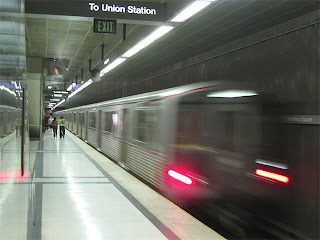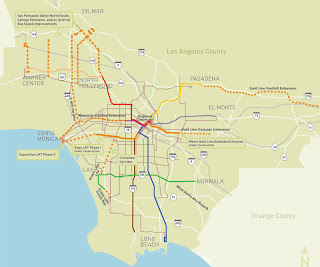To get its required 2/3 vote the proposed 1/2-cent L.A. County transportation sales tax will have to meet critical needs for voters across the county. That it was designed as a compromise package to fund a number of long-sought projects, both transit and roads, hasn't stopped some critics from complaining. The flagship new Westside project is the "Subway to the Sea", to receive $4,074 million, enough to open to Westwood in phases by the mid-2030s. The Expo Line phase 2 from Culver City to Santa Monica, although already budgeted in the Long Range Transportation Plan (LRTP), would receive funding to assure its timely completion in 2013-15.
The flagship new Westside project is the "Subway to the Sea", to receive $4,074 million, enough to open to Westwood in phases by the mid-2030s. The Expo Line phase 2 from Culver City to Santa Monica, although already budgeted in the Long Range Transportation Plan (LRTP), would receive funding to assure its timely completion in 2013-15.
Other Westside projects include advancing the Crenshaw line from the 2020s to 2016-18, including service to LAX, and extending the Green Line to the South Bay Galleria.
New for both the San Fernando Valley and Westside is $1 billion for the I-405 Connector from the Valley to Westwood, a critical alternative to this freeway pass. SFV north-south Bus Rapid Transit lines along the Canoga right-of-way and north-south boulevards would be accelerated. Similarly, the flagship project for the San Gabriel Valley is the Foothill Extension of the Pasadena Gold Line to Claremont. Here are Congressmembers David Dreier and Hilda Solis at a press conference on the right-of-way by Citrus College in Azusa on March 26. Foothill is not funded in the LRTP, and would receive $735M from the sales tax.
Similarly, the flagship project for the San Gabriel Valley is the Foothill Extension of the Pasadena Gold Line to Claremont. Here are Congressmembers David Dreier and Hilda Solis at a press conference on the right-of-way by Citrus College in Azusa on March 26. Foothill is not funded in the LRTP, and would receive $735M from the sales tax.
The Regional Connector across downtown L.A. between the Blue/Expo and Gold Lines would receive $160 million, with expectation of easy qualification for federal match.
Other SGV projects include extending the Eastside Gold Line and initial funding for the 710 freeway "gap closure" tunnel under South Pasadena.
Supervisor Mike Antonovich called for "Equity" in the form of allocating dollars based in population by subregion. But that supposes people only travel where they live. A resident of Palmdale who drives across the San Fernando Valley to a job in Santa Monica demonstrates how funding should go where it is most needed. Bus advocates call for lower fares and more service in the face of limited operations funds and rising costs. The solution is a bigger pot, which is where 20% of the sales tax would generate $7,880 million for bus operations over 30 years, a 70% annual increase from existing (Draft LRTP) levels.
Bus advocates call for lower fares and more service in the face of limited operations funds and rising costs. The solution is a bigger pot, which is where 20% of the sales tax would generate $7,880 million for bus operations over 30 years, a 70% annual increase from existing (Draft LRTP) levels.
And how regressive is a sales tax that doesn't apply to groceries, rent, transit, utilities, or services?
Bicycle and pedestrian advocates sought a dedicated 1-2%, but will have to lobby local cities to be sure such projects are submitted under the 15% Local Return category. Making neighborhoods more inviting for walking and cycling is a fast, cost-effective way to reduce both traffic and fuel use.
Thursday, July 31, 2008
Sales tax comments
Wednesday, July 30, 2008
Metro's sales tax would fund...
Here's some detail of what would be funded by the proposed 1/2-cent 30-year Los Angeles County sales tax that Metro approved July 24 (StreetsBlog, Bottleneck Blog 1 and 2) putting on the ballot this November, from Metro's Board Report (PDF).
(Note that Assemblyman Mike Feuer's AB 2321, necessary for the measure to go on the ballot, is still pending in the State Senate.)
Here's the overall breakdown of the estimated $40 billion over 30 years:
35% — Transit Capital — New Rail and/or Bus Rapid Transit — $13,790M
3% — Transit Capital — Metrolink within Los Angeles County — $1,112M
2% — Transit Capital — Metro Rail System Improvements, Rail Yards, and Rail Cars — $788M
20% — Highway Capital — Carpool Lanes, Highways, Goods Movement, Grade Separations, and Soundwalls — $7,880M
5% — Operations — Rail (New Transit Projects) — $1,970M
20% — Operations — Bus (Countywide Bus Service Operations, Maintenance, and Expansion. Suspend a scheduled July 1, 2009 Metro fare increase for one year and freeze all Metro Student, Senior, Disabled, and Medicare fares through June 30, 2013) — $7,880M
15% — Local Return — to cities and unincorporated county for major street resurfacing, rehabilitation and reconstruction; pothole repair; left turn signals; bikeways; pedestrian improvements; streetscapes; signal synchronization; and transit — $5,910M
Here's an outline of the "Metro's Five-Point Plan" official description, combined with Attachment A's Total funding from the new sales tax and Expected Completion dates for specific capital projects. I've indicated these projects in dashed orange on the Draft LRTP base maps. Click to enlarge. 1. Rail Expansion
1. Rail Expansion
Goals: To significantly expand the size of the Metro Rail and busway systems; to accelerate and enhance existing rail and bus projects; to serve more communities.
1-A. Expo Light Rail: Culver City to Santa Monica — $925M — FY 2013-5
1-B. Crenshaw Corridor (project acceleration) — $1,207M — FY 2016-18
1-C. Regional Connector — $160M (+ $708M federal) — FY 2023-25
1-D. Westside Subway Extension — $4,074M — $2034-36
1-E. Gold Line Eastside Extension — $1,271M — FY 2033-35
1-F. Gold Line Foothill Light Rail Extension — $735M — FY 2015-17
1-G. Green Line Extension to South Bay — $272M — FY 2033-35
1-H. Green Line Extension to LAX — $200M — FY 2015-28
1-I. S.F. Valley N-S: Canoga Corridor (proj. acc.) — $182M — FY 2014-16
1-J. S.F. Valley N-S: East Corridors (proj. acc.) — $68.5M — FY 2016-18
1-K. West Santa Ana Branch Corridor — $240M — FY 2025-27
1-L. S.F. Valley I-405 Corridor Connection — $1,000M — FY 2038-39
1-M. Metrolink Capital Improvements
1-N. Metro Rail Capital
1-O. Eastside Light Rail Access (Gold Line) — $30M — 2013
2. Local Street Improvements
Goals: To synchronize traffic signals to ease traffic flow; to accelerate pothole repair and other maintenance on local streets; to make neighborhood streets and intersections safer for drivers, bicyclists and pedestrians in each community.
2-A. Signal Synchronization
2-B. Major Street Resurfacing & Pothole Repair
2-C. Traffic Monitoring Programs
2-D. Bicycle Programs
2-E. Pedestrian Improvement Program
2-F. Safer Bus Stops
2-G. Traffic Demand Management
Goals: To relieve highway traffic congestion throughout Los Angeles County; to enhance highway safety and improve traffic flow.
3-A. I-5: SR-134 to SR-170 — $271.5M (+$264M state) — FY 2013
3-B. I-5: I-605 to OC Line — $264.8M (+$834M state) — FY 2016-17
3-C. I-5/Carmenita Rd. — $138M (+$154M state) — FY 2015
3-D. I-5/SR-14 — $90.8M (+$41M state) — FY 2013-15
3-E. I-405, I-110, I-105 and SR-91: South Bay — $906M — TBD
3-F. I-5 North: SR-14 to Kern County Line (Truck Lanes) — $410M — TBD
3-G. I-710 South and/or Early Action Projects — $590M — TBD
3-H. SR-138 Capacity Enhancement — $200M — TBD
3-I. High Desert Corridor (environmental) — $33M — TBD
3-J. I-605 Corridor “Hot Spot” Interchanges — $590M — TBD
3-K. Highway ... Arroyo Verdugo Subregion — $170M — TBD
3-L. Highway ... Las Virgenes and Malibu Subregion — $175M — TBD
3-M. I-710 North Gap Closure (Tunnel) — $780M — TBD
4. Better Public Transportation
Goals: To keep public transportation affordable, especially for seniors and the disabled; to expand proven bus transit methods; to extend the convenience of public transportation.
4-A. Rapid Bus Improvements
4-B. Express Bus Improvements
4-C. Local Bus Improvements
4-D. Improved Service for Seniors
4-E. Improved Service for the Disabled
4-F. Fare Equity
4-G. Increased Bus Service to Rail Stations
4-H. Expanding Community-based Shuttle Services
4-I. Increased Local Transit Funding
5. Quality of Life
Goals: To ensure that people and freight can move freely in Los Angeles County; to enable the local economy to prosper; to enable residents to enjoy safety, clean air and a high quality of life.
5-A. Alternative to High Gas Prices
5-B. Significant Economic Impacts
5-C. Job Stimulus
5-D. Reduced Traffic Congestion
5-E. Local Air Quality Improvements
5-F. Live/Work Opportunities
5-G. BNSF Grade Separations in Gateway Cities
5-H. Alameda Corridor East Grade Separations Phase II
5-I. Countywide Soundwall Construction
5-J. Metro and Municipal Clean Fuel Bus Facilities and Rolling Stock
